These vegan seitan steaks are purely next-level! Wonderfully juicy and with a chewy, meaty texture, I dare say they're even better than the real thing, but I might be biased 😉
With this recipe, you will be able to make the best vegan steak from scratch and you won't believe that the base for this recipe is: flour! Yes, you read that right - but trust me, this recipe has nothing to do with bread, so please read on to find out how to turn a bag of flour into tasty vegan steak.

There are plenty of delicious recipes out there when it comes to vegan alternatives, however, I think steak is still one of those ones that seem impossible to enjoy on a vegan diet.
Let's be real: vegan steak will never be just like real steak, no matter what anyone tries to tell you! We're not trying to 100% replicate anything here, but for me personally, this vegan steak recipe is simply delicious and works brilliantly as a replacement for me - and I am certain that loads of people will feel the same way, hence why I'm sharing it here with you.
At the end of the day, recipes like this one make it a whole lot easier to leave meat off your plate, and that's always a win!
Why this recipe works
- it's made from flour! And yes, it's pure magic.
- it's fun to make and feels super creative
- the vegan beef steak turns out wonderfully juicy, chewy and soft
- the steak works really well as shredded chunks as well and they are perfect for freezing and using in other dishes!
- it's packed with flavor thanks to the homemade flavor paste used in the recipe
- the recipe has simple step-by-step instructions, so even if you're new to making vegan meat replacements aka 'mock meat' from scratch, you'll be able to make this at home
What is vegan steak made of?
These vegan steaks are made out of seitan.
What is Seitan?
'What is seitan' you might ask, so here's a quick explanation: Seitan is made from wheat gluten, and it has been around for thousands of years. First detected in Asian cuisines, it was used by Buddhist monks as a protein source.
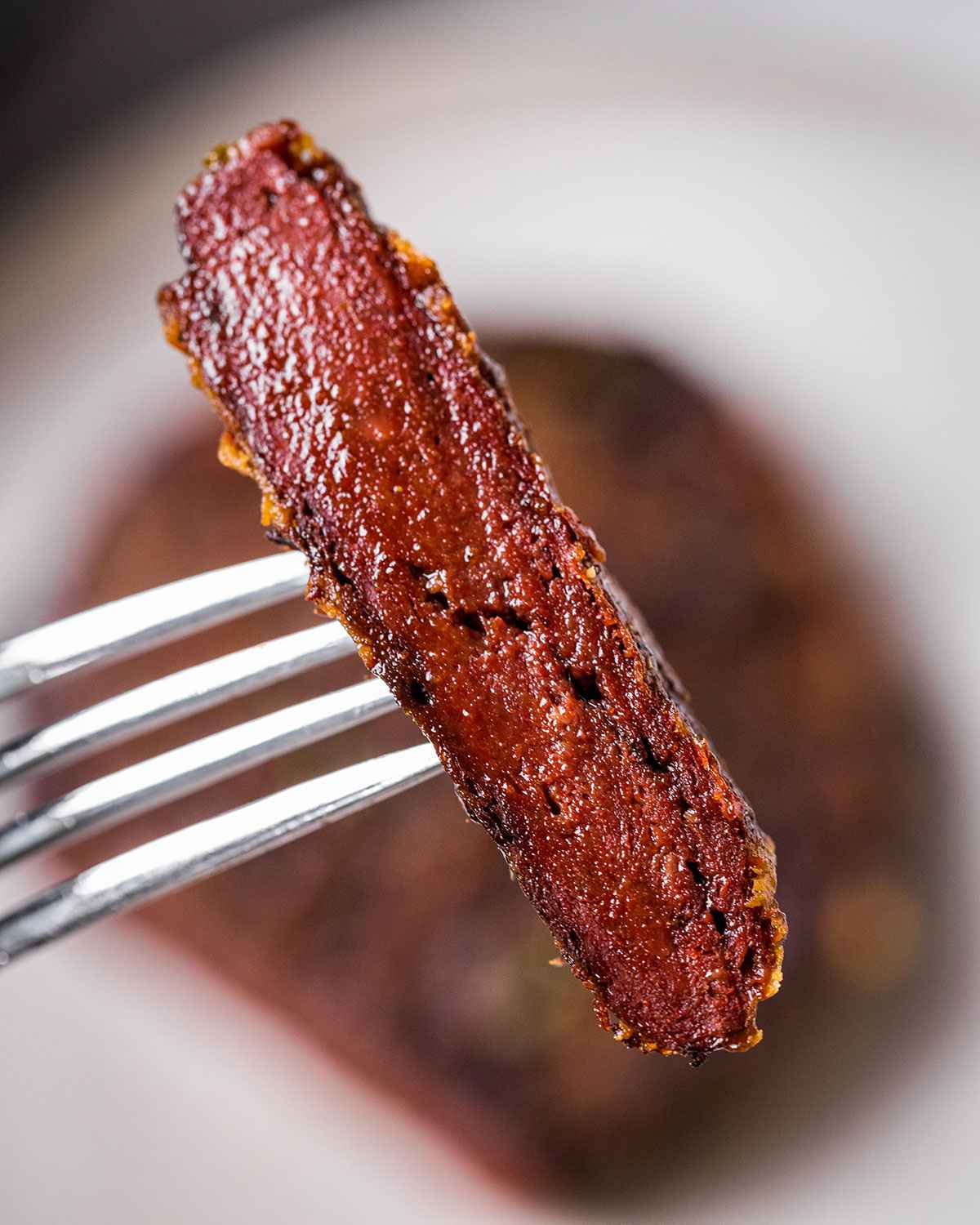
How to make Seitan?
There are 2 main techniques to making seitan from scratch, and I'll give you a brief outline of both methods here to explain the differences and why I chose 1 version over the other for this recipe:
Flour washing method
Flour washing is the OG method when it comes to making seitan! In this method, a dough ball is created with flour and water. The dough ball is then kneaded under water to 'wash' out the starches. The wheat starch in flour is water solulable, so when the dough ball is kneaded and washed under water, these starches will be released into the water. What you're left with is a ball of gluten and this is the base for our steaks in this recipe.
Vital Wheat Gluten method
The vital wheat gluten method is often used in vegan cooking. Vital wheat gluten is basically a flour that is made of washed, dried flour. It is pure gluten and is made of about 80% protein.
As this is a dry flour, both dry flavors, such as herbs and spices, and liquid seasonings can be added to the gluten flour to create Seitan.
Differences between vital wheat gluten and flour washing method
Apart from both methods being essentially different approaches, there are pros and cons to both of them.
Flour washing gives you full control over the composition of gluten and starch in your Seitan, but it's also more time and labor intense, especially as the seitan needs to rest between the different stages of the recipe.
When creating the dough ball, only water and flour are used - as adding other ingredients into the dough at this stage would be a waste when they're washed out right after. Flavor gets added into the washed flour through the cooking process, pan searing and braising in this case, and also with a flavor paste that includes loads of seasonings and spices. This flavor paste is blended into the seitan dough after the washing process and it requires the dough ball to rest in order to come back together.
One big pro for the flour washing method is the great texture, as it often brings out juicier, softer and chewy texture than the vital wheat gluten method does.
The pros for vital wheat gluten is that not much can go wrong when following a recipe, whereas flour washing requires a bit of practice. It's also quicker as the flavored seitan dough is created in the very first step, and the mixing, washing, blending and resting is skipped.
The method using vital wheat gluten often creates a denser texture, which might not be what you're after for all types of seitan recipes. It also comes with a particular 'gluten' taste, which is difficult to describe - but if you've tried vital wheat gluten a couple of times, you might know what I'm talking about! This flavor often needs to be overpowered with seasonings and other additions.

Why the flour-washing method is better for steaks
For this juicy steak recipe, I've chosen to use the flour washing method as it results in a juicier steak and honestly gives the best texture and also a great flavor for this recipe.
Why would a vegan want to eat vegan steak?
The most common misconception around veganism is that all vegans are vegan for the same reason and have the same opinions and preferences. This is far from the truth though: The vegan community is as varied as any other community in the world!
Whilst some vegans might be put off by the flavor and texture of meat, others used to really enjoy these foods before making a conscious choice to go vegan, e.g. for ethical reasons. Creating foods like this seitan recipe, gives those a chance to still enjoy the foods they like and/or grew up with, without compromising their ethical views.
Long story short: Seitan and other vegan meats aren't hurting anyone, and that's fantastic!
Ingredients & Ingredient Notes
For the Seitan base:

- Strong White Flour: Flour is the base and main ingredient for this vegan seitan steak recipe. In order to make Seitan, it's best to use a flour with at least 12% protein. If the flour bag doesn't mention the flour percentage, simply check the nutritional information and make sure the flour contains 12 or more grams of protein per 100 grams. The higher the percentage, the more gluten will be in the flour and the less wheat starch, resulting in a bigger seitan steak.
- Canola Oil: Also called 'rapeseed oil'. It's pretty flavor-neutral and perfect to fry the seitan steaks in as it neither adds nor takes away from the seitan flavor. You can also use olive oil if you like.
- Vegetable Stock: For braising the seitan. I like to use homemade stock, if I have it to hand, or Kallo stock cubes (bouillon cubes). Simply use your favorite vegetable bouillon and check the packaging to see if it's vegan friendly.
- Vegan-friendly ale: Adds additional umami flavor to the steak and is a fabulous addition to the braising liquid.
- Tamari: tamari soy sauce is stronger in flavor than dark or light soya sauce that is often used for dipping. I prefer using tamari as it holds more flavor and a bottle of it lasts me a whole lot longer than regular soya sauce.
- French mustard: I like to use dijon mustard to glaze these steaks before pan-searing them. It adds tasty flavors straight to the 'crust' of the steak!
- All-purpose flour: for dusting the vegan steaks before pan-searing, helps to give the steak a light crust.
For the flavor paste:

- Nutritional yeast: often also called 'nooch' in vegan slang! This stuff is like vegan cr@ck! It's a fantastic seasoning and also healthy as it contains a lot of vitamins and minerals. It's also high in protein, but you'd have to eat a load of it for that too make a big contribution to your diet, just FYI. Nutritional yeast is not the same as baker's yeast. It's actually non-active yeast and it's kinder on your digestive system. It has a naturally lightly cheesy flavor and is therefore often used in vegan cheese recipes, such as my Ultimate Vegan Cheese Sauce. If you can't find it in grocery stores, order it from your local Amazon page.
- Beetroot powder: it's nutritious but mainly used to add a bit of natural coloring to the steak.
- Bouillon powder: packs a lot of flavor into the seitan.
- Cocoa powder: don't worry, your steak won't taste like chocolate - the cocoa powder adds a wonderful warm note to the recipe, alongside some lightly bitter notes and gives the steak a more rounded overall flavor.
- Instant coffee: similar to the cocoa, don't worry, this won't overpower the flavor of your steak.
- Seasoning: For this basic steak recipe, I only add onion and garlic powder to the flavor paste. Any other flavors you might want to add to the steak, should be added to the pan-glaze before serving or be part of a sauce drizzled onto the steak.
- Soya Sauce & Oil: Both tamari soya sauce and groundnut oil are part of the flavor paste. Tamari is a fantastic all-round seasoning and the oil adds a little moisture and elasticity to the seitan.
- Food coloring: red food coloring is optional for this recipe. Seitan is naturally often a grey color, which doesn't look as appetizing, depending on the recipe, so I like to add a tiny bit of red food coloring gel in order to lift up the color of the steak. I recommend using a high-quality gel, instead of liquid supermarket food coloring (let's be honest those aren't very good!).
See recipe card for full quantities.
Equipment
- Large bowl: To combine all ingredients into a dough ball, but also for resting and flour washing.
- Food processor: In this method, the food processor is used to thoroughly combine the washed seitan dough with the flavor paste. It's extremely difficult to do this by hand, so I definitely recommend using a food processor to make this step easier.
- Skillet or grill pan: I like to use something non-stick, a griddle pan or alternatively cast iron for a rustic flavor.
Instructions
This seitan steak recipe is truly not complicated at all, but for best results, the seitan should rest in between the different stages. This will create the best texture!
Sure, resting will take a little more time than whipping some store-bought meat alternatives into the skillet - but it is so worth it, so be patient!

Start by combining the flour and water into a firm dough ball.

Knead it on a floured surface for 2 minutes, then set aside to rest for 15-20 minutes.
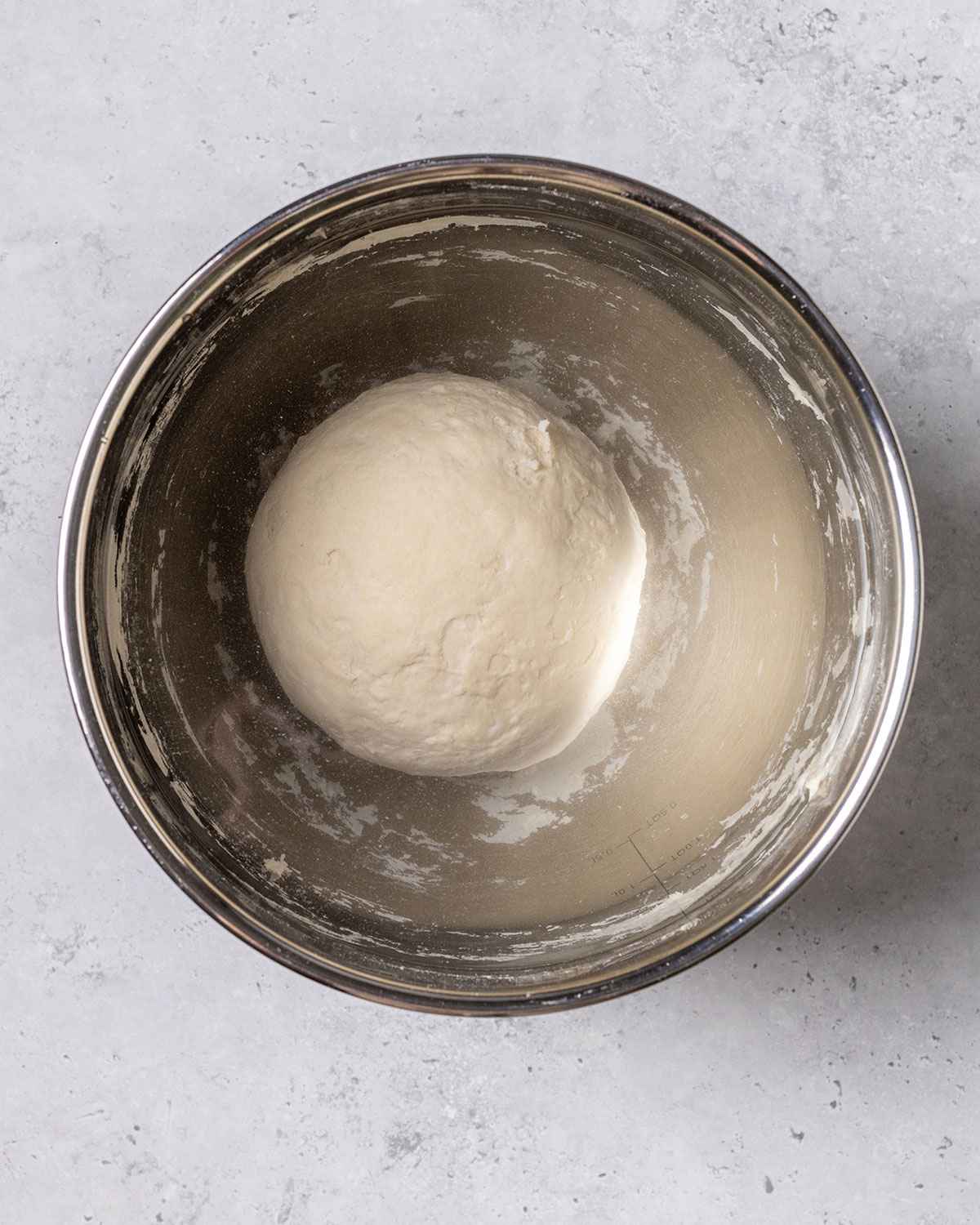
Place the dough ball into a large bowl and fill it with water until the dough is completely submerged. Set aside for 45 minutes.
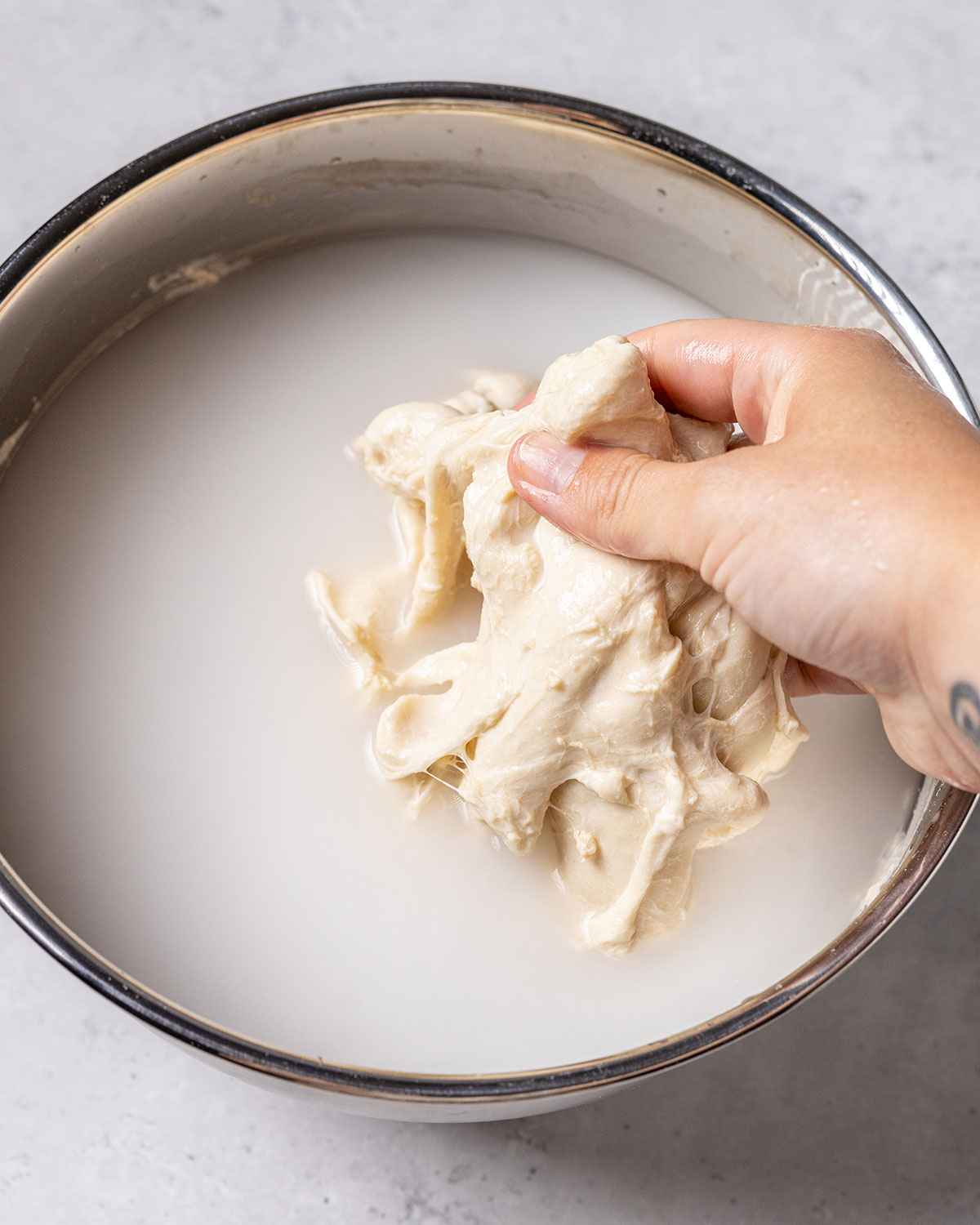
Begin kneading the dough ball under water. This is called 'washing the flour. Drain and rinse the water 4-5 times, every time it gets super white and creamy. You should wash out the majority of the wheat starch, but not all.

This is what it should look like after. Don't worry if the dough begins to fall apart, it will come back together in the next steps.
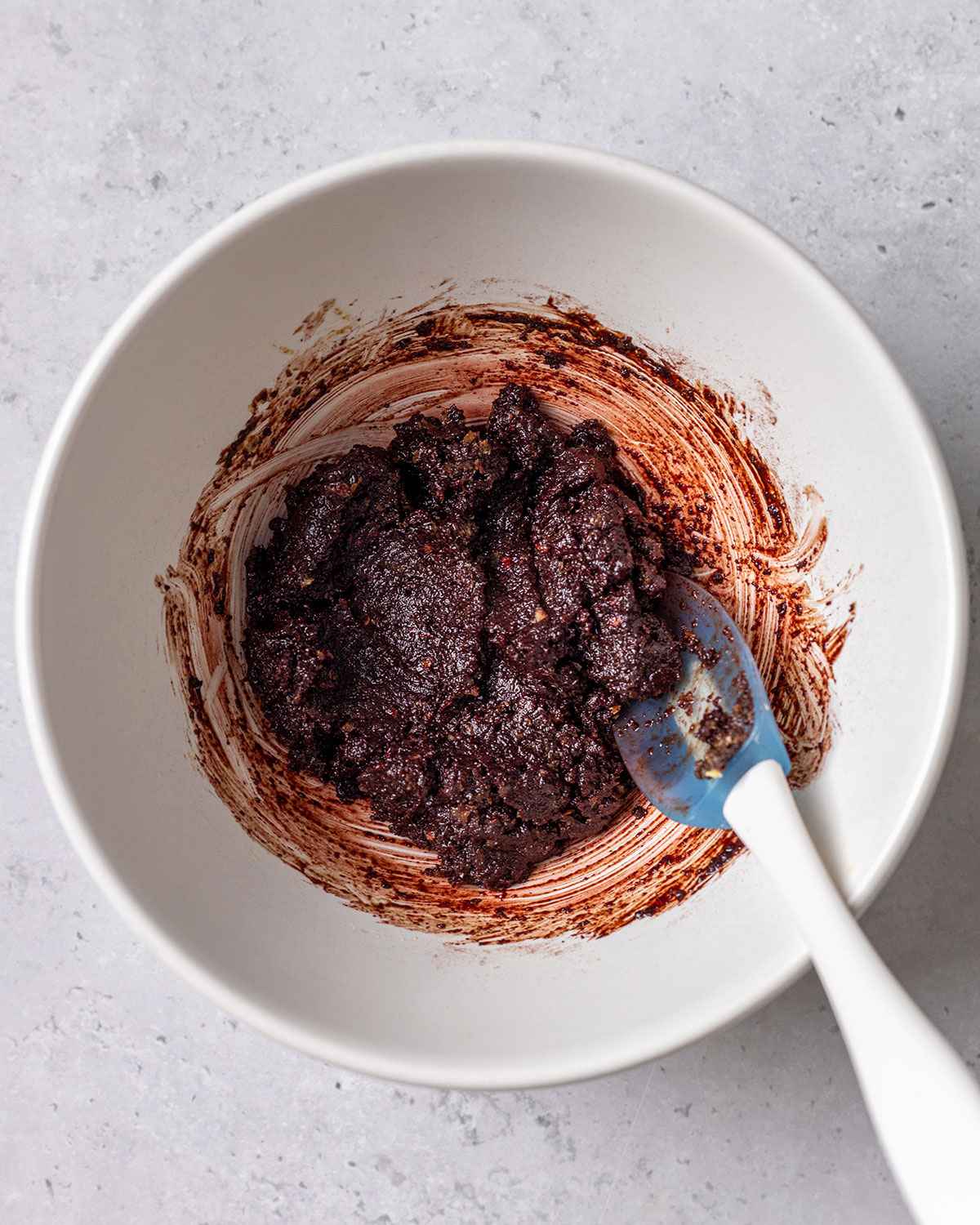
Combine all ingredients for the flavor paste.
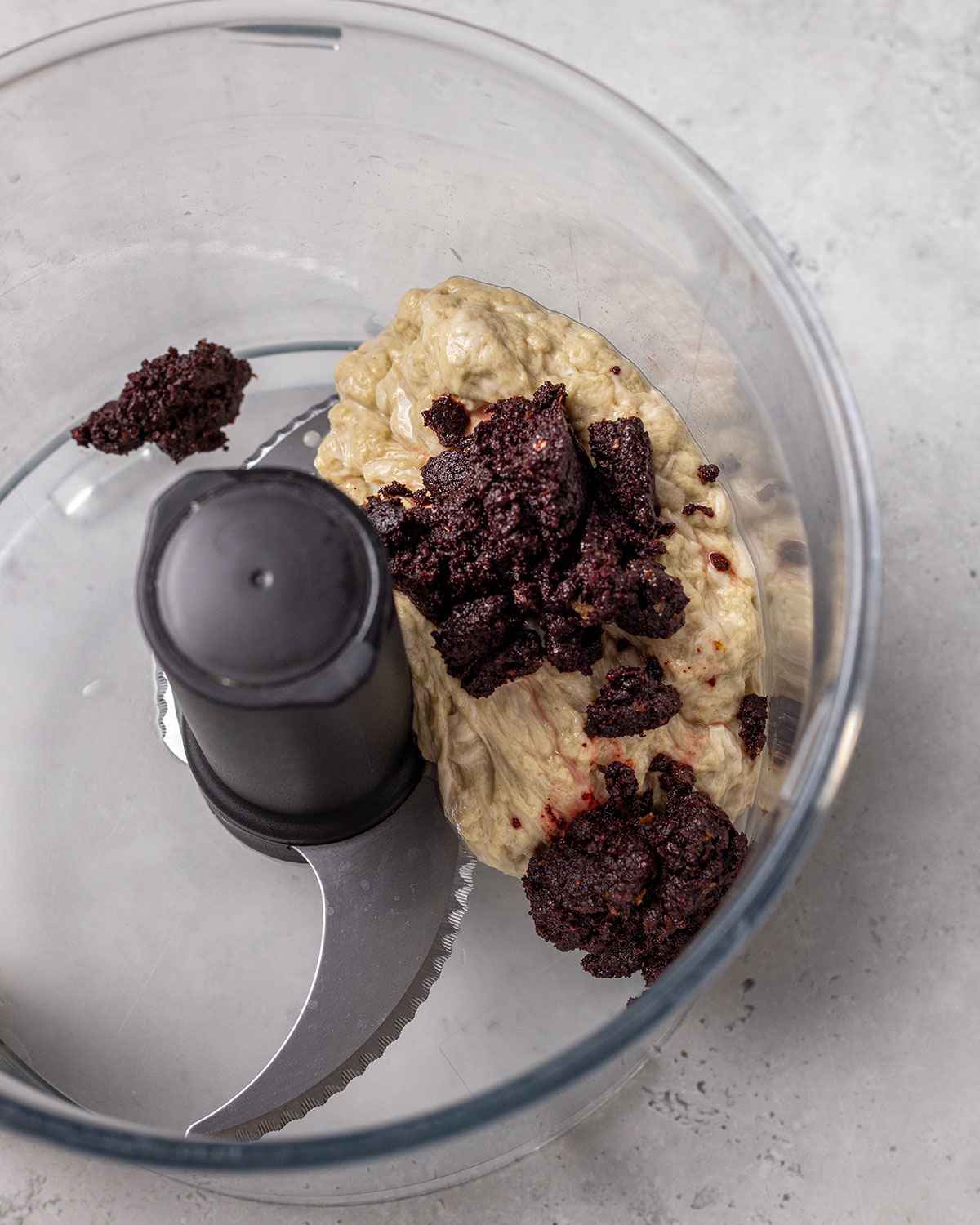
Transfer the washed dough into the food processor alongside the flavor paste and pulse 15-20 times or until the paste and dough are well combined.
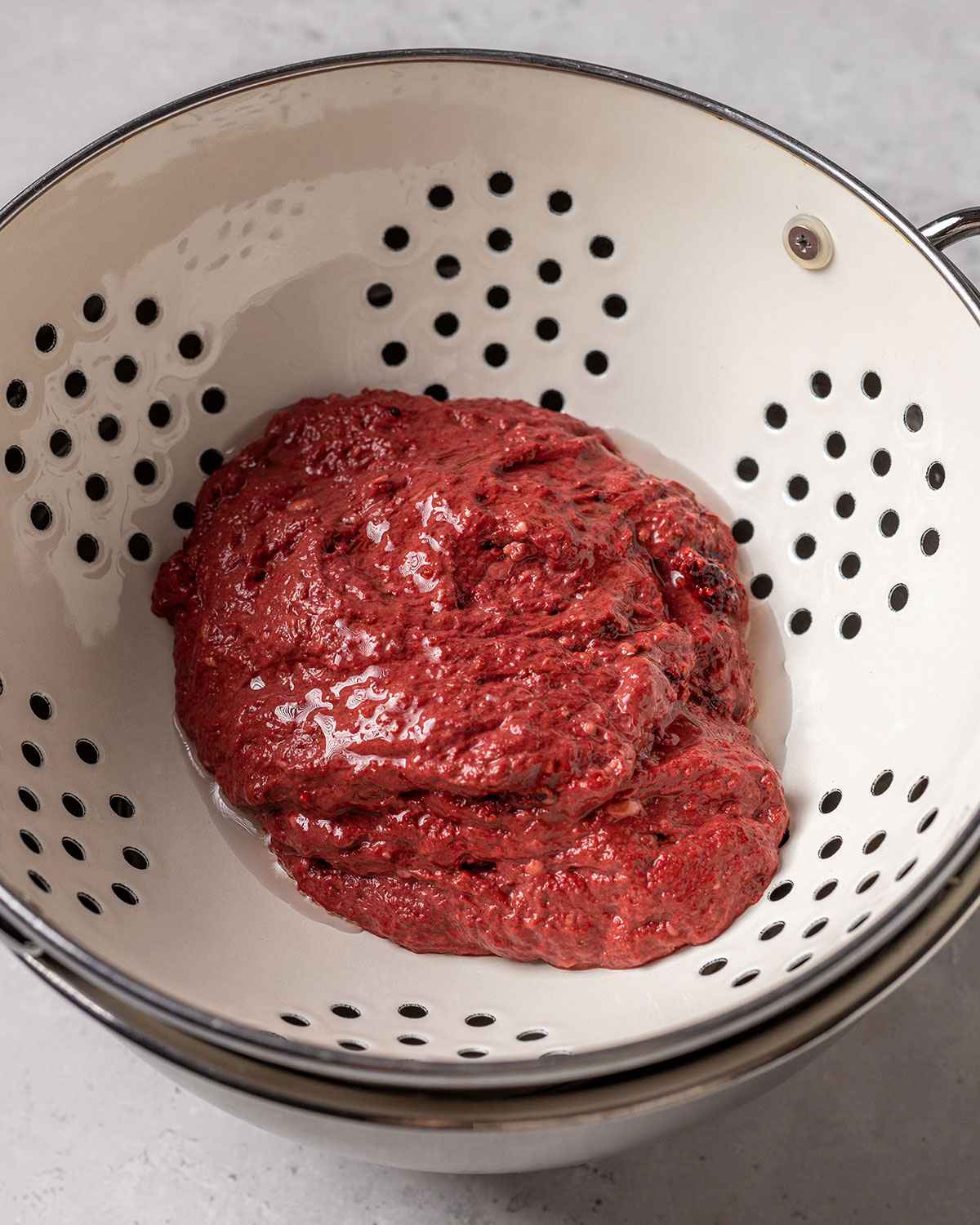
Place the Seitan into a bowl and colander, drizzle with a little oil, cover the bowl and allow for it to rest in the fridge for a minimum of 2 hours, or up to 2 days.

Divide the Seitan into individual steaks, gently shape them between your hands, then heat the canola oil in a skillet or frying pan and place the Seitan inside. Lightly sear on both sides over medium-high heat.

Pour the stock and ale into the skillet, reduce the heat to medium-low and cover with a lid. Braise for 20-25 minutes, flipping the steaks halfway through.

Remove the lid and cook until the majority of the liquid has cooked off.

Drizzle the steaks with the soy sauce and remove from the heat after another minute.

Allow for the steaks to cool down. For the best texture, let them rest over night.

You could just pan-fry the steaks to heat them up, but I prefer brushing them with mustard, dusting them with a little flour and then panfrying in a little oil. This gives them an added layer of flavor and a delicious 'skin'.
Hint: To speed things up, you can mix your dough ball in the food processor with a dough hook. I regularly use my Magimix to put together the simple dough ball - and also to incorporate the flavor paste into the vegan seitan steaks, and it's making it all so much easier!
Serving
There are many delicious ways to serve these vegan steaks:
- alongside roast potatoes and steamed veg
- on a sandwich cause why not!
- cut into small chunks and added to a dish as a beef replacement, e.g. casserole
- seared on an outdoor grill or placed on the BBQ (to prevent it from sticking, brush it generously with oil or use aluminum foil!)
- as part of a festive meal or vegan roast dinner
- delicious alongside potato wedges, or basically potatoes in any shape 🙂


Substitutions
If you need to make a few ingredient swaps for this recipe, here are some tipps:
- Ale - instead of ale, you can also use red wine! It will give a different flavor, but just as delicious! It'll be a little sweeter then the beer version. If you don't want to add alcohol at all, then replace it with vegetable stock / vegetable broth.
- Tamari - Instead of tamari soya sauce, you can also use coconut aminos. Use 2 tablespoons of liquid aminos for every tablespoon of tamari in the recipe.
- Beetroot powder & food coloring - these are adding a lovely color to the steaks, but don't add to the flavoring, so they are optional. If you leave them out completely, the steaks will have a grey-ish color.
- Mustard & flour - Brushing the steaks with mustard and dusting them with a little flour at the end is totally optional! It's how I enjoy my Seitan steaks the most, but you can easily skip this and just pan-fry your steaks in a little oil.
- Bouillon powder - instead of powder, you can also use a stock cube. crumble it up and dissolve it in the flavor paste
Variations
Feel free to add additional flavors to your seitan if you're in the mood for experimenting. Here are a few ideas:
- Spicy - add chili pepper flakes or smoked paprika powder into the flavor paste for a spicy kick
- Smoky - for a smoky flavor, add a teaspoon of liquid smoke into the flavor paste.
- Tomato - tomato paste is another ingredient that brings a great twist into the steak! Blend it in with the flavor paste, but make sure you don't add too many liquids to the paste as it can otherwise be difficult for the seitan to take it all on.
- Red wine: swap out the vegan-friendly ale for red wine in the braising process. This will give the steak a sweeter flavor.
If you like this recipe, then also see this Chicken-style seitan on my website!
Storage & Making Ahead
You can store the cooked steaks in an airtight sealed container in the fridge for up to 2 days. The best way to store them after the braising process, right before the final pan frying and serving.
Alternatively, you can also store the washed and seasoned dough ball in the fridge for up to 2 days. During this time, the seitan will become firmer and chewier in texture, adding a decent bite to the final steaks!
Frequently Asked Questions
Absolutely! When placing this seitan steak onto a barbecue or grill, just make sure to add enough oil to the skin of the steak to prevent it from sticking and use a drip tray underneath to catch any droppings.
This is normal! It will become super soft and shaggy and easily fall apart. It will come back together in the resting phase after blending in the flavor paste, so trust the process!
Related Recipes
If you enjoy making homemade Seitan or similar recipes, then give these favorites from the blog a go:
📌 If you love Pinterest you can pin any of the images to your boards!
📖 Recipe Card

Vegan Steak (Seitan Recipe)
Ingredients
- 2 cups strong white flour (500 g) minimum 12% protein
- 1 cup water (250 ml)
- 1 tablespoon canola oil (14 ml) rapeseed oil
- ½ cup vegetable stock (120 ml)
- ½ cup vegan-friendly ale (120 ml)
- 2 tablespoon tamari soya sauce (30 ml)
- 4 tablespoon French dijon mustard (30 ml)
- 4 tablespoon all-purpose flour (32 g)
For the flavor paste:
- 1 tablespoon nutritional yeast (5 g)
- 1 tablespoon beetroot powder (10 g)
- 1 tablespoon bouillon powder (14 g)
- 2 teaspoon cocoa powder (4 g)
- 1 teaspoon instant coffee
- 1 teaspoon onion powder
- ½ teaspoon garlic powder
- 1 tablespoon groundnut oil (14 ml)
- 2 teaspoon tamari soya sauce (10 ml)
- ⅛-1/4 teaspoon red food coloring gel (optional)
Instructions
Creating the dough ball
- Start by combining the flour and water into a firm dough ball. You can do this by hand in a large mixing bowl, or simply add both ingredients to a food processor with a dough hook. Firmly knead the dough ball on a lightly floured surface, then set it aside to rest for 20 minutes. During this time the gluten texture will develop.
- Transfer the dough ball into a large bowl and fill it with water until the dough is completely submerged. Set aside for 45 minutes.
Washing the flour
- Begin washing the dough ball under water using your hands. Simply begin kneading and stretching the dough. After a few minutes, you will notice that the wheat starch is releasing into the water and the water will become white. Once the water becomes creamy and saturated with wheat starch, drain the water, fill the bowl with fresh water and repeat the process. Drain and rinse the water 4-5 times, every time it gets super white and creamy. You should wash out the majority of the wheat starch, but not all.Don't worry if it feels like your dough ball is becoming very loose and falls apart - this is normal! The texture will come back together in the next steps, just trust the process.
Flavoring the Seitan
- Whilst you rest the washed dough ball in a sieve to drain excess liquid, combine all ingredients for the flavor paste in a small bowl.
- Place the washed seitan into a food processor, add the flavor paste and pulse 15-20 times or until the paste is incorporated.
Resting
- Transfer the Seitan to a bowl, drizzle with a little oil to coat and cover with a lid. Set the Seitan aside to rest in the fridge - ideally over night for the best texture, but if you're in a rush, rest it at least 2 hours. You can rest the Seitan up to 2 days in the fridge.
Pan searing
- Divide the Seitan into individual steaks - I recommend making 2 steaks from this recipe, but decide on a size that works for your recipe. Gently shape the seitan between your hands.
- Heat the canola oil in a skillet and place the Seitan inside. Lightly sear on both sides over medium/high heat and use a spatula to gently press the steaks into the hot skillet.
- Pour the stock and ale into the skillet, reduce the heat to medium-low and cover with a lid. Braise for 20-25 minutes, flipping the steaks halfway through. Remove the lid and allow for the rest of the liquid to cook off.
- Sprinkle the steaks with tamari, flip and remove from the heat after a minute.
Final resting + heating
- Allow for the steaks to cool down. For the best texture, let them rest over night.
- To heat, brush the steaks with mustard and coat in a thin layer of flour, then pan fry them in a little oil until hot. Alternatively, you can leave out the mustard and flour and pan fry them straight in a little oil.
Notes
- flour: make sure to use a flour with at least 12% protein, ideally 14% or more.
- discarding the wheat starch: it is best not to put the starch water down the sink as it could otherwise accumulate and block your pipes. You can set the starch water aside in a large bowl or jug, wait for the starch to settle at the bottom, discard the top water and use the starch water in recipes, such as starch water bacon or even to make vegan cheese! Find a few simple recipes on the Seitan Society Website.
- Don't rush it: for best results, stick to the resting times of the recipe - they determine the texture of the Seitan steaks! If you rush it, the Seitan might become too soft and not have a nice bite.
- Spongy texture: If the temperature on the stove is too hot for the Seitan, it could become spongy. It's a little trial and error as every stove is a little different. Give the recipe a go, and adjust it in the next round if needed! If the steaks don't work out the first time around, shred the Seitan and use it in stir fries, curries or casseroles.
Latest Recipes
*Disclosure: This page may contain affiliate links and sponsored links that earn me a small commission, at no additional cost to you. You can find more information in my Privacy Policy.
© 2024 Romy London / Romina Callwitz | All images, videos, wordings and content are copyright protected and belong to Romina Callwitz. Please do not use any of my content without prior permission. If you wish to re-publish any (part of my) content, please get in touch via email. Thanks for your support!









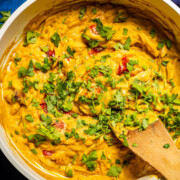
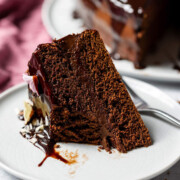









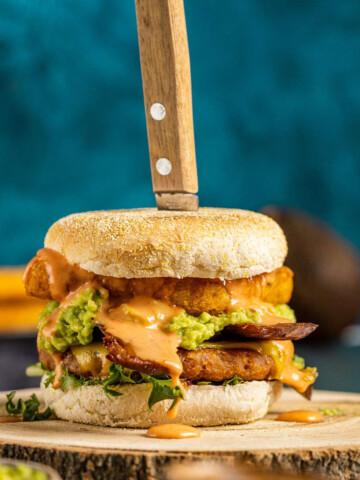


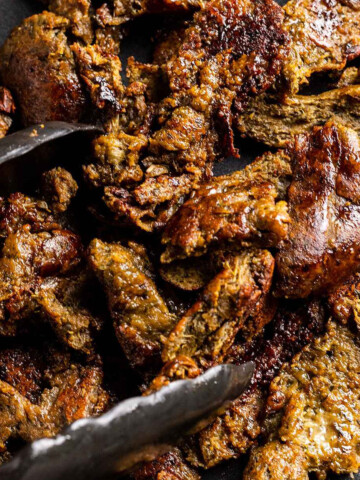

Chris
hands down the BEST vegan steak recipe I've tried so far! I loved this texture. left out the flour/mustard fry at the end and it was pure magic!
Carrie
Followed and made this in the span of 2 days. Marinating the gluten overnight definitely helps the flavor absorb more. I did not use enough tamari during the fry/simmer but the steak still tasted very bold and flavorful! Thank you for this recipe !
romylondonuk
Thanks so much for the lovely review, Carrie! So glad to hear you enjoyed it 🙂 I just added some more Seitan recipes to the blog as well, if you love cooking with Seitan - have a look on the homepage under 'Recent Recipes' 🙂